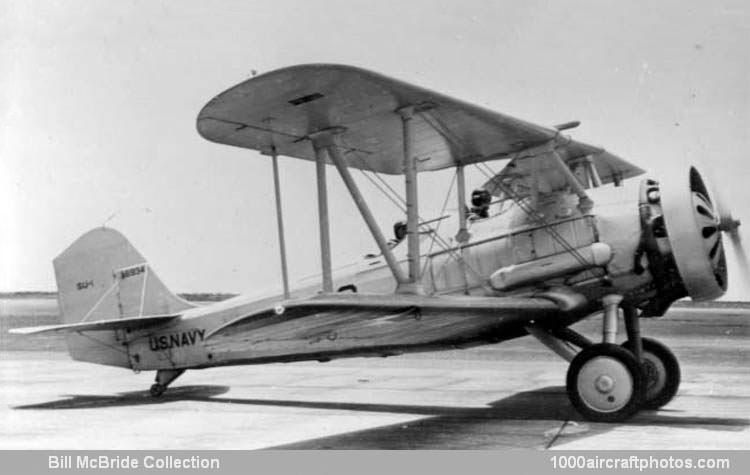01/31/2013. Remarks by Johan Visschedijk: "Soon after moving into a new factory at East Hartford, Connecticut, in association with United Aircraft Corporation, the Chance Vought company continued its highly successful series of Corsair biplanes with a new model for the USN. Designated O3U-1 and delivered in 1930, this new Corsair was but a small improvement on the O2U-4, distinguished primarily by an increase in sweepback and dihedral on the lower wing, which now matched the upper wing. All other characteristics, including the 450 hp Pratt & Whitney R-1340C Wasp engine, were the same, but the newly developed Grumman amphibious float was adopted for this model. Production totaled 87 (BuNos. A-8547 to A-8582, A-8810 to A-8839, A-8851 to A-8871) all going to USN observation units aboard carriers, battleships and cruisers.
Major changes occurred in the next model, the O3U-2, which was powered by the 600 hp Pratt & Whitney R-1690 Hornet engine with a low drag cowling. The fin shape was changed to incorporate a small dorsal fin, and the tripod-type landing gear of the O2U series was dropped in favor of the simpler straight-axle type which had been featured on the two O2U-1 prototypes. The Scarff ring in the rear cockpit was deleted and the cockpit details changed. Armament consisted of one fixed forward-firing 0.30 in (7.62 mm) machine gun and two 0.30 in (7.62 mm) guns in rear cockpit.
Production of the O3U-2 totaled 29 (BuNos. A-8872 to A-8875, A-8928 to A-8937, A-9062 to A-9076), but all were redesignated SU-1s in the Scout category almost as soon as they reached Navy units. In this role they equipped Marine Squadrons VS-14M and VS-15M from 1932 to 1934 aboard the USS Saratoga and Lexington as the only Marine units to serve on aircraft carriers prior to WW II. Reverting to the Pratt & Whitney Wasp, but in its 550 hp R-1340-12 version, the O3U-3 had a new, more rounded rudder which increased the overall length by 20 in (0.51 m). Delivery of the 76 built (BuNos. A-9142 to A9169, 9283 to 9330) began in June 1933, and all but two of the total were in service in 1935 aboard battleships and with utility units attached to carriers and shore stations.
Another batch of the Hornet-powered Corsairs appeared with the designation O3U-4, and all but one of the 65 were redesignated in the Scout category, 43 (BuNos. A-9077, A-9079 to A-9108, A-9110 to A-9121) became SU-2s and 20 (BuNos. A-9122 to A-9141) became SU-3s with minor equipment changes. Another (BuNo. A-9109) became the XSU-4 with a long-chord engine cowling, a full canopy over the two cockpits, enlarged tail plane and rudder shape as on the O3U-3. The 40 (BuNos. 9379 to 9398, 9414 to 9433) production models designated SU-4 were the only Corsairs built from scratch in the Scout category. They reverted to the narrow-chord cowling of the O3U-3 but had larger tails. The SU-4s replaced SU-1s in the Marine unit aboard USS Lexington until 1934, and served in various utility roles with USN units.
One O3U-4 (BuNo. A-9078) became the XO3U-5 to test new ideas for the observation role, and the final O3U-3 (BuNo. 9330) became the XO3U-6 with a full-chord cowling for the Wasp engine and a partial canopy between the cockpits. These prototypes led to a final order for 32 O3U-6s (BuNos. 9729 to 9744, 0001 to 0016), delivered to the Marines and divided equally between VO-8M and VO-7M in 1935. The first O3U-6 was tested as a single-float seaplane, but the Marine units did not operate them in this configuration. Another experiment was made on the last O3U-6 in January 1937, when it was tested with full-span ailerons and larger fin as the XOSU-1.
By the end of 1941 the Corsair biplanes had been replaced in operational units, but 33 O3U-1s, 35 O3U-3s, 6 O3U-6s and 67 assorted SU models were still on strength and distributed around naval air stations. Shortly before the war the Naval Aircraft Factory at Philadelphia converted a small number of O3U-6s to drone configuration for flight testing under extreme conditions where a pilot might be endangered. The conversion involved use of a fixed nose wheel landing gear."
